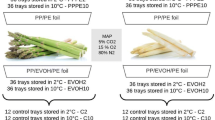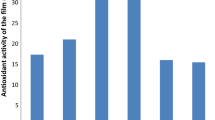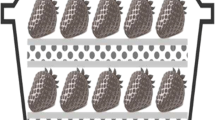Abstract
Active food packaging containing antimicrobial additive goes beyond traditional functions of packaging, once it can extend food shelf life maintaining its quality, safety and reducing postharvest losses by controlling food spoilage. Among several antimicrobial additives employed in polymeric films for packaging, metallic nanoparticles outstand due to its facility for synthesis, low-cost of production, and intense antimicrobial properties. In this work, extruded plain films of low-density polyethylene (LDPE) containing silver nanoparticles (AgNPs) embedded in SiO2 and TiO2 carriers (namely MS and MT, respectively) were produced and used as active packaging for maintaining the physicochemical and microbiological quality of carrots (Daucus Carota L. cv. Brasília). The neat (LDPE) and composite films containing MS and MT were characterized by scanning electron microscopy and permeability to oxygen and used for packaging fresh-cut sliced carrots stored at 10 °C for 10 days. After the storage time, the physicochemical properties of carrots were characterized, while the antimicrobial properties of films and AgNP migration were investigated. Our results revealed that both MT and MS packages showed antimicrobial activity even for films containing low concentration of AgNP. In addition, AgNP antimicrobial activity demonstrated to be carrier-dependent, once MT-LDPE showed improved performance compared to MS-LDPE. Regarding the physicochemical properties of packaged carrot, lower soluble solids and weight loss and higher levels of ascorbic acid were observed for carrots packaged with MT-LDPE films (compared to MS-LDPE), leading to a better postharvest quality conservation. Such differences observed in physicochemical properties of carrots are related to the distinct antimicrobial and film permeability properties for each composite film. In addition, under the conditions employed in this study, AgNP migration from the packages to fresh-cut carrot was not observed, which is highly desirable for food packaging safety, indicating the potential of such active packages for food preservation application.











Similar content being viewed by others
References
Adolfo Lutz Institute. (2008). Métodos físico-químicos para análise de alimentos (4th ed.). São Paulo: Instituto Adolfo Lutz. 1020 p.
Alasalvar, C., Al-Farsi, M., Quantick, P. C., Shahidi, F., & Wiktorowicz, R. (2005). Effect of chill storage and modified atmosphere packaging (MAP) on antioxidant activity, anthocyanins, carotenoids, phenolics and sensory quality of ready-to-eat shredded orange and purple carrots. Food Chemistry, 89, 69–76.
Ali, N. A., & Noori, F. T. M. (2014). Gas barrier properties of biodegradable polymer nanocomposites films. Chemistry and Materials Research, 6(1), 44–51.
AOAC. (2002). Official methods of analysis (17th ed.). Washington, DC: Association of Official Analytical Chemists International.
ASTM International (2005). ASTM D 3985–05: Standard test method for oxygen transmission rate through plastic film and sheeting using a coulometric sensor. Philadelphia 7p.
Azeredo, H. M. C. (2013). Antimicrobial nanostructures in food packaging. Trends in Food Science & Technology, 30(1), 56–69.
Becaro, A., Puti, F. C., Correa, D. S., Paris, E. C., Marconcini, J. M., & Ferreira, M. D. (2015a). Polyethylene films containing silver nanoparticles for applications in food packaging: characterization of physico-chemical and anti-microbial properties. Journal of Nanoscience and Nanotechnology, 15(3), 2148–2156.
Becaro, A. A., Jonsson, C. M., Puti, F. C., Siqueira, M. C., Mattoso, L. H. C., Correa, D. S., Ferreira, M. D. (2015b). Toxicity of PVA-stabilized silver nanoparticles to algae and microcrustaceans. Environmental Nanotechnology, Monitoring & Management, 3, 22–29. doi:10.1016/j.enmm.2014.11.002.
Bosetti, M., Masse, A., Tobin, E., & Cannas, M. (2002). Silver coated materials for external fixation devices: in vitro biocompatibility and genotoxicity. Biomaterials, 23, 887–892.
Cabezas-Serrano, A. B., Amodio, M. L., Cornacchia, R., Rinaldi, R., & Colelli, G. (2009). Suitability of five different potato cultivars (Solanumtuberosum L.) to be processed as fresh-cut products. Postharvest Biology and Technology, 53, 138–144.
Chitarra, M. I. F., & Chitarra, A. B. (2005). Pós-colheita de frutos e hortaliças: fisiologia e manuseio (2nd ed.). Lavras: UFLA. 785 p.
Cushen, M., Kerry, J., Morris, M., Cruz-Romero, M., & Cummins, E. (2014). Evaluation and simulation of silver and copper nanoparticle migration from polyethylene nanocomposites to food and an associated exposure assessment. Journal of Agricultural and Food Chemistry, 62(6), 1403–1411.
Downes, F. P., & Ito, K. (Eds.). (2001). Compendium of methods for the microbiological examination of foods (4th ed.). Washington: APHA. 676 p.
EFSA (2005). Opinion of the scientific committee on a request from EFSA related to a harmonised approach for risk assessment of substances which are both genotoxic and carcinogenic. http://www.efsa.eu.int/science/sc_commitee/sc_opinions/1201_en.html.
Emmambux, N. M., & Minnaar, A. (2003). The effect of edible coatings and polymeric packaging films on the quality of minimally processed carrots. Journal of Science of Food and Agriculture, 83(10), 1065–1071.
Fernández, A., Soriano, E., Lopez Carballo, G., Picouet, P., Lloret, E., Gavara, R., et al. (2009). Preservation of aseptic conditions in absorbent pads by using silver nano-technology. Food Research International, 42, 1105–1112.
Fernández, A., Picouet, P., & Lloret, E. (2010). Cellulose-silver nanoparticle hybrid materials to control spoilage-related microflora in absorbent pads located in trays of fresh-cut melon. International Journal of Food Microbiology, 142, 222–228.
Goyeneche, R., Roura, S., & Di Scala, K. (2014). Principal component and hierarchical cluster analysis to select hurdle technologies for minimal processed radishes. LWT - Food Science and Technology, 57, 522–529.
Griffitt, R. J., Brown-Peterson, N. J., Savin, D. A., Manning, C. S., Boube, I., Ryan, R., Brouwer, M. (2012). Effects of chronic nanoparticulate silver exposure to adult and juvenile sheepshead minnows (Cyprinodon variegatus). Environmental Toxicology and Chemistry, 31, 160–217
Hong, H., Qiu, J., & Liang, Y. (2010). Environmental factors influencing the distribution of total and fecal coliform bacteria in six water storage reservoirs in the Pearl River Delta Region, China. Journal of Environmental Sciences, 22(5), 663–668.
Kaiser, H. F. (1958). The varimax criterion for analytic rotation in factor analysis. Psychometrika Urbana, 23(3), 187–200.
Kimura, F. T., & Miller, V. (1957). Chromic oxide measurement. Improved determination of chromic oxide in cow feed and feces. Journal of Agricultural and Food Chemistry, 5, 216.
Klaiber, R. G., Baur, S., Koblo, A., & Carle, R. (2005). Influence of washing treatment and storage atmosphere on phenylalanine ammonia-lyase activity and phenolic acid content of minimally processed carrot sticks. Journal of Agricultural and Food Chemistry, 53(4), 1065–1072.
Kreutzmann, S., Christensen, L. P., & Edelenbos, M. (2008). Investigation of bitterness in carrots (Daucuscarota L.) based on quantitative chemical and sensory analyses. LWT--Food Science and Technology, 41(2), 193–205.
Lima, K. S. C., Grossi, J. L. S., Lima, A. L. S., Alves, P. F. M. P., Coneglian, R. C. C., Godoy, R. L. O., & Sabaa-Srur, A. U. O. (2001). Efeito da irradiação ionizante γ na qualidade. Ciência e Tecnologia de Alimentos, 21(2), 202–208.
Lima, K. S. C., Lima, A. L. S., Luchese, R. H., Godoy, R. L. O., & Sabaa-Srur, A. U. O. (2003). Cenouras minimamente processadas em embalagens com atmosferas modificadas e tratadas com radiação gama: avaliação microbiológica, físico-química e química. Ciência e Tecnologia de Alimentos, 23(2), 240–250.
Luo, Z., Wang, Y., Jiang, L., & Xu, X. (2014). Effect of nano-CaCO3-LDPE packaging on quality and browning of fresh-cut yam. LWT - Food Science and Technology. doi:10.1016/j.lwt.2014.09.021.
Mastromatteo, M., Conte, A., & Del Nobile, M. A. (2012). Packaging strategies to prolong the shelf life of fresh carrots (Daucus carota L.). Innovative Food Science & Emerging Technologies, 13, 215–220.
Mohammed Fayaz, A., Balaji, K., Girilal, M., Kalaichelvan, P. T., & Venkatesan, R. (2009). Mycobased synthesis of silver nanoparticles and their incorporation into sodium alginate films for vegetable and fruit preservation. Journal of Agricultural and Food Chemistry, 57, 6246–6252.
Nasiri, A., Shariaty-Niasar, M., & Akbari, Z. (2012). Synthesis of LDPE/Nano TiO2 nanocomposite for packaging applications. International Journal of Nanoscience and Nanotechnology, 8(3), 165–170.
Olkhov, A. A., Vlasov, S. V., Iordanskii, A. L., Zaikov, G. E., & Lobo, V. M. M. (2003). Water transport, structure features and mechanical behavior of biodegradable PHB/PVA blends. Journal of Applied Polymer Science, 90(6), 1471–1476.
Radziejewska-Kubzdela, E., Czapski, J., Czaczyk, K., & Biegańska-Marecik, R. (2014). The effect of pre-treatment and modified atmosphere packaging on contents of phenolic compounds and sensory and microbiological quality of shredded celeriac. Journal of the Science of Food and Agriculture, 94(6), 1140–1148.
Ragaert, P., Devlieghere, F., & Debevere, J. (2007). Role of microbiological and physio-logical spoilage mechanisms during storage of minimally processed vegetables. Postharvest Biology and Technology, 44, 185–194.
Saltveit, M. E. (2003). Fresh-cut vegetables. In J. A. Bartz & J. K. Brecht (Eds.), Postharvest physiology and pathology of vegetables (pp. 691–712). New York: Marcel Dekker.
Simon, P., Chaudhry, Q., & Bakos, D. (2008). Migration of engineered nanoparticles from polymer packaging to food—a physicochemical view. Journal of Food Nutrition Research, 47, 105–113.
Siracusa, V. (2012). Food packaging permeability behaviour: a report. International Journal of Polymer Science, 2012, 1–11.
Solberg, M., Buckalew, J. J., Chen, C. M., Schaffner, D. W., O’neil, K., McDowell, J., Post, L. S., & Borderck, M. (1990). Microbiological safety assurance system for foodservice facilities. Journal of Food Technology, 44, 68–73.
Walczak, A. P., Fokkink, R., Peters, R., Tromp, P., Herrera Rivera, Z. E., Rietjens, I. M., Hendriksen, P. J., & Bouwmeester, H. (2012). Behaviour of silver nanoparticles and silver ions in an in vitro human gastrointestinal digestion model. Nanotoxicology, 7, 1198–1210.
Weinkauf, D. H., & Paul, D. R. (1990). The effects of structural order on barrier properties. In W. J. Koros (Ed.), Barrier polymers and structures, chapter 3 (p. 60). Washington: American Chemical Society.
Yang, W., Shen, C., Ji, Q., An, H., Wang, J., Liu, Q., & Zhang, Z. (2009). Food storage material silver nanoparticles interfere with DNA replication fidelity and bind with DNA. Nanotechnology, 20, 85–102.
Zhang, S., Yu, Y., Xiao, C., Wang, X., & Tian, Y. (2013). Effect of carbon monoxide on browning of fresh-cut lotus root slice in relation to phenolic metabolism. LWT - Food Science and Technology, 53, 555–559.
Acknowledgments
The authors are grateful to CNPq, FAPESP, CAPES, MCTI, and Embrapa from Brazil for financial support.
Author information
Authors and Affiliations
Corresponding author
Rights and permissions
About this article
Cite this article
Becaro, A.A., Puti, F.C., Panosso, A.R. et al. Postharvest Quality of Fresh-Cut Carrots Packaged in Plastic Films Containing Silver Nanoparticles. Food Bioprocess Technol 9, 637–649 (2016). https://doi.org/10.1007/s11947-015-1656-z
Received:
Accepted:
Published:
Issue Date:
DOI: https://doi.org/10.1007/s11947-015-1656-z




